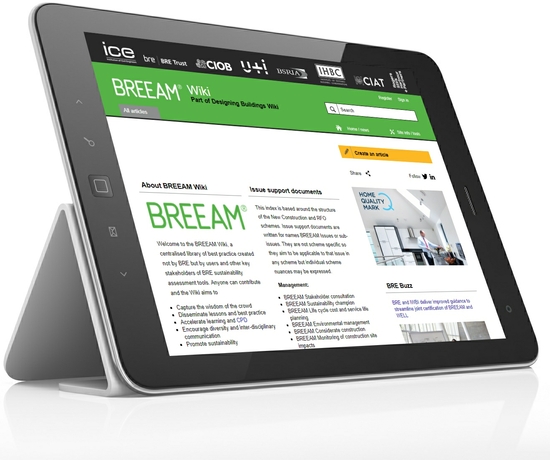BREEAM Wiki launched
[edit] 
[edit] BREEAM Wiki launched on 23 April 2018. Created by its users and stakeholders, BREEAM Wiki will advance knowledge sharing and collaborative solutions for the BRE family of sustainability tools.
BREEAM Wiki is part of the widely-used Designing Buildings Wiki, which is already an established favourite for the construction community with 3.7 million users a year. BREEAM Wiki promotes the uptake of sustainability by disseminating BREEAM best practice and lessons learnt, and making it easier for a diverse range of collaborators to share their knowledge. The development of the Wiki comes at a time when there is increasing evidence that crowd-sourced knowledge is more comprehensive and representative.
There are already more than 160 articles on BREEAM Wiki, together with a specially-written series of Issue Support Documents created to disseminate the most immediately-useful information for individual sustainability topics.
Paul Thistlethwaite of BREEAM said; “We have set up the BREEAM Wiki within Designing Buildings with an emphasis on ease and accessibility. It is designed to allow a wide range of interested parties to contribute. You can add a single line to an existing article and add value in less than a minute. The wisdom of the crowd often outstrips that of a few experts and that is a resource that we want to harness.”
Co-founder of Designing Buildings Wiki, Dr Gregor Harvie, said; “Sustainability is all about working together for the common good. BREEAM Wiki is a fantastic opportunity for practitioners to share what they know and help others create a more sustainable environment. There’s already lots of great information on BREEAM Wiki, and it will get even better as more people engage with it.”
To contribute to BREEAM Wiki go to https://www.designingbuildings.co.uk/BREEAM_Wiki
[edit] Notes
BREEAM is the world’s leading sustainability assessment method for masterplanning projects, infrastructure and buildings. It recognises and reflects the value in higher performing assets across the built environment lifecycle, from new construction to in-use and refurbishment. BREEAM does this through third-party certification of the assessment of an asset’s environmental, social and economic sustainability performance, using standards developed by BRE. This means BREEAM-rated developments are more sustainable environments that enhance the wellbeing of the people who live and work in them, help protect natural resources and are more attractive property investments. https://www.breeam.com/
Designing Buildings Wiki is used by 3.7 million people a year to find and share construction industry knowledge. Created in 2012, it includes 6,500 articles about the planning, design, construction and operation of built assets. Everyone is free to write about things they know and to find out about things they don’t. Users can add their profile to articles they write, so when people read them, they find out about the author too. Every change is checked to ensure that the high quality of the site is maintained.
Designing Buildings Wiki is supported by; The Institution of Civil Engineers, Rogers Stirk Harbour + Partners, The Chartered Institute of Building, The Institute of Historic Buildings Conservation, U and I Group PLC, BRE Trust, BSRIA and The Chartered Institute of Architectural Technologists. https://www.designingbuildings.co.uk
Featured articles and news
Latest Build UK Building Safety Regime explainer published
Key elements in one short, now updated document.
UKGBC launch the UK Climate Resilience Roadmap
First guidance of its kind on direct climate impacts for the built environment and how it can adapt.
CLC Health, Safety and Wellbeing Strategy 2025
Launched by the Minister for Industry to look at fatalities on site, improving mental health and other issues.
One of the most impressive Victorian architects. Book review.
Common Assessment Standard now with building safety
New CAS update now includes mandatory building safety questions.
RTPI leader to become new CIOB Chief Executive Officer
Dr Victoria Hills MRTPI, FICE to take over after Caroline Gumble’s departure.
Social and affordable housing, a long term plan for delivery
The “Delivering a Decade of Renewal for Social and Affordable Housing” strategy sets out future path.
A change to adoptive architecture
Effects of global weather warming on architectural detailing, material choice and human interaction.
The proposed publicly owned and backed subsidiary of Homes England, to facilitate new homes.
How big is the problem and what can we do to mitigate the effects?
Overheating guidance and tools for building designers
A number of cool guides to help with the heat.
The UK's Modern Industrial Strategy: A 10 year plan
Previous consultation criticism, current key elements and general support with some persisting reservations.
Building Safety Regulator reforms
New roles, new staff and a new fast track service pave the way for a single construction regulator.
Architectural Technologist CPDs and Communications
CIAT CPD… and how you can do it!
Cooling centres and cool spaces
Managing extreme heat in cities by directing the public to places for heat stress relief and water sources.
Winter gardens: A brief history and warm variations
Extending the season with glass in different forms and terms.
Restoring Great Yarmouth's Winter Gardens
Transforming one of the least sustainable constructions imaginable.























